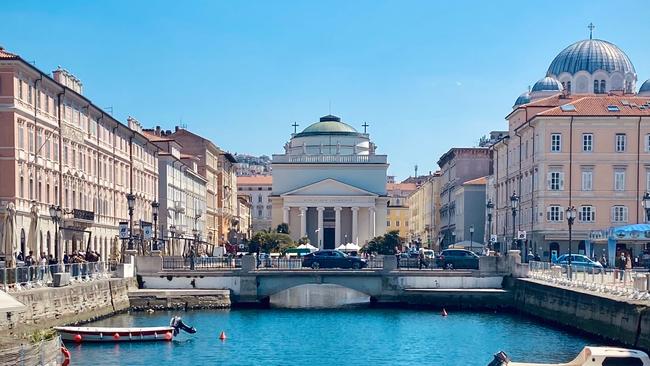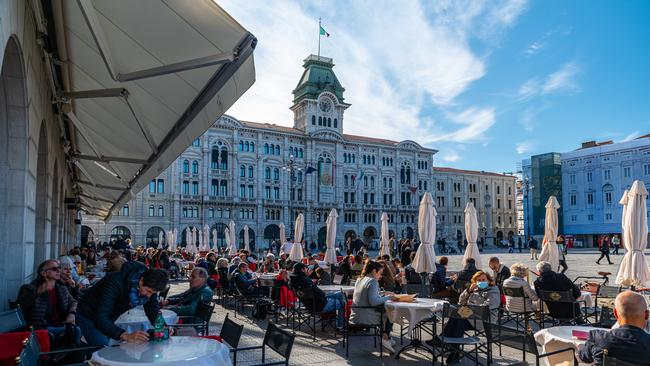Exploring Trieste, Italy’s unexpected coffee capital
The 19th century tradition of trading and roasting beans is alive and well in the port city, where cafe culture is core.

As the sun sinks into the horizon over the Adriatic Sea we raise our glasses of Campari Spritz and toast our long-delayed arrival in the famous Italian port city of Trieste.
Two weeks of quarantine have frustrated our travel plans, but the clear skies and open waterfront vistas of this grand northeastern Italian city, a two-hour drive from Venice, are just the tonic we need.
Of course, Trieste is famous for another tonic – coffee – and we waste no time immersing ourselves in the cafe culture. The port of Trieste became a Mediterranean hub for trading and roasting coffee beans in the 19th century and some of the city’s historic cafes are still in business today.
We start at the famous Caffe degli Specchi, on the vast, central Piazza Unita d’Italia, a plaza surrounded by grand palazzi that opens directly on to the waterfront. Founded in 1839, the cafe is the last of four that used to occupy the piazza, playing host over the years to literary figures, political agitators and, at one point after World War II, the British Navy HQ. It is now owned by the Faggiotto family of pastry chefs and chocolatiers, which explains why the cafe’s rich, dark, hot chocolate is renowned.

We take an outside seat in the piazza and quickly learn the first lesson of Triestine coffee culture: that it has its own lingo. An espresso, we discover, is called a nero, while a cappuccino served in a small glass is known as a “capo in b”. In Trieste, where the rate of coffee consumption is said to be almost twice the national average, apparently even visiting Italians can be tripped up by the jargon.
From the Piazza Unita d’Italia we stroll to the Mole Audace, a pier that stretches 200m into the Gulf of Trieste, and then along the waterfront to Eataly, a gourmet food market on three levels where we stock up on Italian treats and enjoy pasta and wine overlooking the harbour. Meandering back to the historic part of Trieste we scale the hill to Castello di San Giusto, a fortress dating back to the 15th century with stunning city views. On the way down, we browse antique shops and book stores, taking time to peruse eclectic wares in the sprawling La Rigatteria in Via Malcanton.
On another day we make our way to the pastry shop once frequented by one of Trieste’s most famous literary denizens, James Joyce. From 1910-12 the Irish expat lived in the same street as the Pasticceria Caffe Pirona and was said to be partial to its stuffed horseshoe-shaped pastry called presnitz, which is still sold in the impeccably preserved shop. But for a quick coffee, a relaxed read or an aperitif with atmosphere, the historic establishment that tops them all for us is the charming Cafe San Marco. Founded in 1914, it combines cafe, bookshop and restaurant, all warmly furnished in the Liberty style, the Italian version of art nouveau.
We’re staying just out of town in a house along the Strada Costiera, the spectacular coastal road that skirts the cliffs fronting the Gulf of Trieste and at one point tunnels through a massive overhanging karst outcrop. On the hillside above are vineyards, olive groves and villages, while below are grand cliffside villas and the scenic little port of Santa Croce, which is accessible via a steep path.
Jutting into the gulf on a headland below the Strada Costiera is Castello di Miramare, the 19th-century castle built by the ill-fated Archduke Ferdinand Maximilian at a time when Trieste still served as the thriving seaport for the Habsburg Empire. We explore the extensive park grounds and then gaze out to sea from the castle terrace, imagining Maximilian sailing off with his wife Charlotte in 1864 for his short and disastrous stint on the Mexican throne.
From the castle we wander back to the city along the picturesque foreshore promenade to the bakery-restaurant Il Pane Quotidiano, where we take a seafront pew and settle in for another spectacular sunset.


To join the conversation, please log in. Don't have an account? Register
Join the conversation, you are commenting as Logout